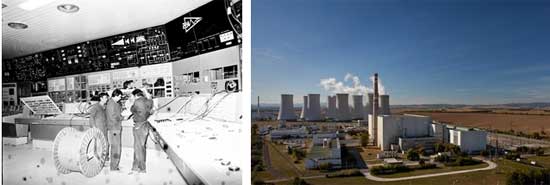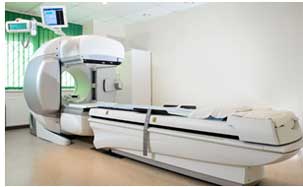
The Development of nuclear power in Slovakia
The nuclear power industry in Slovakia and in the Czech Republic was built on a basis of the integrated nuclear program of the former Czechoslovakia. So, until 1993, the Czech and Slovak Republics had a common power system. Both countries were building pressurized water reactors (PWRs) together (at Jaslovské Bohunice, Dukovany, Temelín, and Mochovce).
A1 Nuclear Power Plant at Jaslovské Bohunice
The era of the nuclear power industry began in the former Czechoslovakia in August 1958 by the construction of the prototype A1 Nuclear Power Plant in Jaslovské Bohunice, which was equipped with a KS 150 heavy water type reactor and used natural uranium as a fuel source. It was cooled by gaseous CO2. The Unit was in operation since October 1972 till February 1977, when it was permanently shut down. At present, the A1 NPP is undergoing the Decommissioning Stage II Program.
Bohunice V1 Nuclear Power Plant
The construction of V1 Nuclear Power Plant with VVER 440/V 230 type reactors was launched in Jaslovské Bohunice on 24 April, 1972. Unit 1 of V1 NPP was put into trial operation in December 1978 and Unit 2 in March 1980. As a result from a condition under the EU-accession agreement, Unit 1 of V1 NPP was definitively shut down on 31 December 2006 and Unit 2 – on 31 December 2008. At present, V1 NPP is undergoing the Decommissioning Stage I Program.

Bohunice V2 Nuclear Power Plant
During the course of the construction of V1 NPP, due to an assumed deficit in the power balance of Slovakia, it was decided to construct V2 NPP as Units 3 and 4 of the Bohunice power plant. The construction of V2 Nuclear Power Plant with advanced VVER 440/V 213 reactors began in 1976. Both units have been operated safely and reliably since then.

Mochovce Nuclear Power Plant
The construction of Mochovce NPP started in June in 1981. The NPP project was planned as a four-unit plant. Unit 1 began to supply electricity to the power grid in the summer of 1998 and Unit 2 - two years later. Both units are equipped with pressurized water reactors of VVER 440/V-213 type. Construction of Units 3 and 4 was suspended in 1992 and re-started in November 2008. Beginning of their operation is expected in 2017 and 2018 respectively.

Research and medical application of nuclear energy
Nuclear research was part of the development of nuclear power in Slovakia. Formed from the original R&D department at the Bohunice site, the Nuclear Power Plant research institute VUJE was established in 1977. Today, VUJE a. s., engineering company performs design, supply, implementation, research and training activities, particularly in the field of nuclear and conventional power generation and is an internationally recognised institution in nuclear research.
Slovak Universities and technical schools have developed programmes of nuclear education and various aspects for the peaceful use of nuclear energy, including fusion.
 Nuclear medicine is a medical specialty that uses radioisotopes for diagnosing and treating diseases. Its origin in Slovakia can be dated in the mid-1950s. Slovakia gradually created 13 departments, not only in most major hospitals, but in individual health centers and private health facilities as well. Nuclear medicine is a medical field training specialists not only for doctors, but also for other professions in the health sector. Nuclear medicine diagnostic section enables imaging, but especially non-invasive examination methods. Today, clinics, centres or departments of nuclear medicine, exist in each larger town as highly specialized institutions in order to develop the most advanced diagnostic methods of medical imaging and laboratory procedures of nuclear and molecular medicine, as well as for the treatment of diseases using open sources. Nuclear medicine is a medical specialty that uses radioisotopes for diagnosing and treating diseases. Its origin in Slovakia can be dated in the mid-1950s. Slovakia gradually created 13 departments, not only in most major hospitals, but in individual health centers and private health facilities as well. Nuclear medicine is a medical field training specialists not only for doctors, but also for other professions in the health sector. Nuclear medicine diagnostic section enables imaging, but especially non-invasive examination methods. Today, clinics, centres or departments of nuclear medicine, exist in each larger town as highly specialized institutions in order to develop the most advanced diagnostic methods of medical imaging and laboratory procedures of nuclear and molecular medicine, as well as for the treatment of diseases using open sources.
Challenges in nuclear development
Nuclear development, however, has not been always straightforward and smooth. In early times nuclear experience was accumulated step-by-step, many times learning from our own mistakes. Technical problems were being solved on the go, at that time shrouded in an environment of secrecy. Nuclear safety was in the cradle and experience was substituted by enthusiasm, safety culture was unknown… All these factors contributed to persistent technical problems and eventually lead to two accidents at the first nuclear power plant A1 after which the plant was permanently shut down.
Construction of all VVER units in Czechoslovakia was strongly opposed by Austria and required a lot of explaining, arguing and diplomacy to put the units into operation despite the fact that the public in Slovakia is generally positive towards nuclear energy. In the EU accession process Slovakia was pushed to close its two oldest VVER units without any technical substantiation, although the units had been upgraded to the internationally accepted safety level.
After the break-up of Czechoslovakia, the Slovak republic needed to replace all federal institutions, including the nuclear regulation authority on the national level. This challenge was coped with efficiently, assuring uninterrupted smooth and safe operation of all NPPs.
The construction of Mochovce NPP units was challenged by strong opposition from Austria and later by organizational and market changes including new majority owner of the operating company, a decrease in electricity demand and a lack of funding. Just two units out of four were completed and construction of third and fourth units was suspended and resumed several years later. Their construction is still going on with anticipated completion in 2017 and 2018 respectively.
Outlook of nuclear development in Slovakia
In spite of those challenges and changing market conditions, we can proudly state that the Slovak nuclear power sector is mature, providing safe and reliable baseload carbon-free electricity. In the light of environmental challenges and conclusions of the Paris COP21 climate change conference, nuclear will have to be a part of the Slovak energy mix for the coming decades and with the closing of existing nuclear power plants they will be replaced by new ones, using the best technology available.
Slovakia, together with the Visegrad partners - the Czech Republic, Hungary and Poland - joined forces in designing and eventually building a demonstration reactor of the gas-cooled fast neutron type called ALLEGRO. This project will be a driver of nuclear and material research in participating countries and a great opportunity for a new generation of young scientists and technicians to put their hands on cutting edge science and technology.
|

